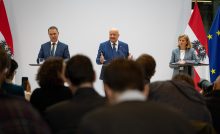

5G graphic elaborations
Poland’s relationship with China has undergone a significant shift in recent years. Yet the economic opportunities that were supposed to come with a closer partnership have not materialized. Below, we look into the causes.
A very sensitive issue: 5G
Poland, where Huawei has been operating since 2004, is where the company’s main headquarters is located for Central & Eastern Europe (CEE) and the Nordic region. Huawei has been a sensitive issue in Chinese-Polish relations since January 2019, when Huawei’s regional sales director was arrested on spying allegations in Poland. Although Warsaw has not offered any final word on 5G equipment providers yet, former US Secretary of State Mike Pompeo strove to convince U.S. allies like Poland within CEE to speak with one voice regarding China.
In September of 2019, Warsaw and Washington signed a joint declaration on 5G, but the Polish government has still sought to retain a neutral stance on Huawei, mostly due to reluctance to take a step ahead of other EU countries. However, one month before former Secretary Pompeo’s visit, Poland’s prime minister declared that all of Europe should stand with the US on 5G, warning of the influence of “companies controlled by an authoritarian regime,” referring to Huawei and ZTE.
Investment relations: Some growth seen, buy many empty promises
Poland’s bilateral relationship with China has undergone a significant shift in recent years. Yet the economic opportunities that were supposed to come with a closer partnership – which led Warsaw to embrace the Belt and Road Initiative in 2015 – have not materialized. Polish policy experts point out that some parts of the economic playing field have become more uneven, and generally regard Europe’s asymmetrical openness to the Chinese market as a problem.
Still, Chinese direct investment in Poland has grown over the last 2-3 years, but the official figures from Poland’s national bank, which don’t include Chinese investment from companies that are not seated in China, are not that impressive: in 2016, Chinese direct investment totaled EUR 123.3 million, while in 2015 it was EUR 198.5 million. For some perspective, Independent researcher the Rhodium Group reports that about EUR 936 million was invested in Poland in 2016 by Chinese interests.
Meanwhile, Chinese companies are slowly getting set up in Poland. For example, TCL and Digital View manufacture LCD panels, Nuctech makes an x-ray inspection system, and LiuGong produces heavy machinery. Branches of four Chinese banks are located in Warsaw, including two of the largest – Bank of China and Industrial and Commercial Bank of China. Three Chinese companies are also listed on the Warsaw Stock Exchange: Peixin International Group N.V., a manufacturer of machinery for the production of hygiene products; JJ Auto CG, a company producing parts for vehicles and heavy machinery; and Fenghua SoleTech, a manufacturer of footwear components for global brands.
Poland’s second-largest source of imports is China and in 2018 the Chinese-Polish trade reached USD 33.47 billion, an increase of 13.3% from the previous year, with Polish exports estimated at USD 2.5 billion and Chinese exports at an estimated USD 30.97 billion. In this cooperation, China exports mobile phones, textiles, computers, and toys to Poland who, in return, exports copper, mechanical equipment, cosmetics, and agricultural products. Additionally, there are currently more than 800 Chinese companies operating in Poland, including, Guangxi Liugong Group, Huawei, and the Bank of China.
Our future take on Chinese FDI in Poland
While Poland welcomes investments from China, its political alliances take center stage, which could curtail any Chinese investments that don’t jibe with those interests. For example, the country appears to be trying to diversify 5G suppliers to balance its own priorities. In this way, Warsaw is striving to avoid a direct confrontation with Beijing, but its relationship with Washington is still of the utmost importance.
Concerning the EU-China Investment Agreement, Poland had urged the EU not to rush things and to cooperate more with Washington, calling for more consultations and transparency as well as bringing the country’s transatlantic allies on board.
Meanwhile, though, China’s future investments in Poland are likely to focus on high-tech projects. With encouragement from Poland’s government, research and development (R&D) are becoming the focus of investment with capital coming from TCL Corporation (which set up an R&D center in 2018), Huawei, and the owners of the TikTok app, ByteDance.
Recent Posts
Austria coalition ends five months of limbo
Austria’s centre-right People’s Party (OVP), centre-left Social Democrats (SPO) and centrist, liberal NEOs have now…
Dodik ban from public office sparks protests in BiH
Republika Srpska (RS) president Milorad Dodik is once again at the centre of political turmoil…
Ukraine, Slovakia ranked most bureaucratic countries
Except for wartorn Ukraine, Slovakia has the most red tape in Central and Eastern Europe…
Trump’s verbal attack on Zelenskyy prompts security rethink in CEE
The dramatic breakdown of relations between Ukrainian President Volodymyr Zelenskyy, US President Donald Trump and…
Trump’s self-defeating trade war with Europe – opinion
US President Donald Trump underscored this week that he intends to impose 25% tariffs on…
Zelenskyy gathers support from CEE leaders
Ukrainian President Volodymyr Zelenskyy called on European leaders to step up their efforts towards peace…



View Comments
Hi all, here every one is sharing such knowledge, therefore
it's good to read this webpage, and I used to pay a visit this blog every day.
Exceptional post however I was wondering if you could write alitte more on this subject? I’d be very thankful if you could elaborate a little bit further.Many thanks!
Hi there just wanted to give you a quick heads up. The text in your post seem to be running off the screen in Opera.
I'm not sure if this is a format issue or something to do with web browser compatibility
but I figured I'd post to let you know. The layout look great though!
Hope you get the issue solved soon. Kudos
viagra 50mg brand - purchase sildenafil purchase viagra pill
prednisolone 10mg canada - oral prednisolone order cialis online cheap
order augmentin 375mg online - buy augmentin without prescription order cialis 20mg without prescription
buy bactrim 480mg generic - cost sulfamethoxazole sildenafil tablets
cephalexin 500mg canada - cleocin for sale purchase erythromycin online
sildenafil 100mg uk - tamoxifen over the counter stromectol where to buy
purchase rhinocort pills - budesonide price antabuse 250mg brand